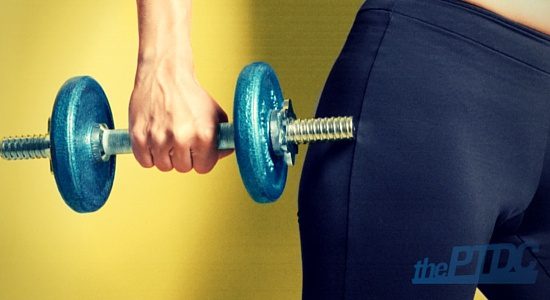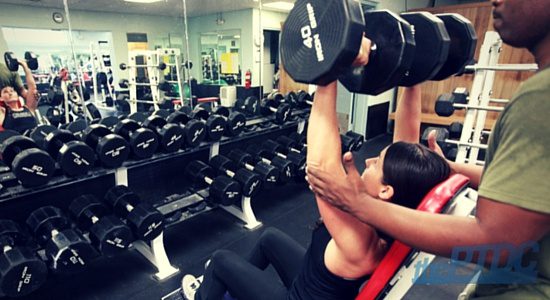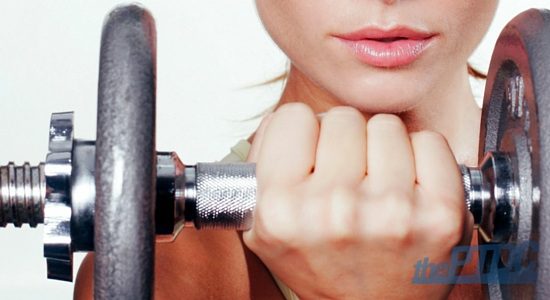As a fitness professional, your main duty is to deliver amazing results for your clients, no matter who they are or their goal. And sometimes a client may be someone who initially balks at the idea of picking up heavy weights, but still wants to have a strong body. In my experience, these clients are more commonly women, though please bear in mind I am not saying this hesitation is unique to females.
Understandably, even in this day and age, preconceived notions of the weight room culture and weightlifting in general still dominate. We've made a lot of strides forward in getting more women into weightlifting, powerlifting, and bodybuilding since Arnold's heyday. That's because some women will jump right in, ready to take on new challenges, while others may take extra time and convincing to feel more comfortable.
For the latter group, I've successfully applied what I'm about to discuss with you toward introducing and transitioning many of my female athletes, including my fiance, to the barbell and other weights. Here's what you can do.
1. Build her up to compound movements with non-weighted movements.
As with anything, start small. Consider putting her on the weight machines or bodyweight exercises to start her off on the right foot. As you already know, bodyweight exercises are a great accessible way for someone to start building strength, at home and at the gym.
Compile different bodyweight workouts that mimic all of the same movements you intend to eventually do with the free weights. The groundwork you lay in this first phase will make the subsequent transition into dumbbells and barbells even easier.
As an example, start her off on a push/pull, primarily upper body, day with:
- Smith machine push-ups
- Smith machine inverted rows
- Bench dips
- Inch worms
- Mountain climbers
- Front planks
Don't forget about the legs either! Incorporate the following:
- Squats jumps
- Lunges
- Sumo squats
- Wall sits
- Bear crawls
- Bent-knee leg lifts
Both free weight machines and bodyweight exercises do a good job eliciting those initial neuromuscular adaptations to get her stronger.
See where her head is after doing these for a while, and see if she's open to more and different exercises. Once she eventually feels and sees the results from those movements, there's little doubt she'd want to try more.
2. Use self-determination theory to get client buy-in.
If you don't already use the self-determination theory, you should learn what it is.
Basically, it's a theory that says everyone has the desire to grow, feel involved, be "in the know", and have some kind of structure that they have some control over.
It's an easy way to help a client become more self-sufficient and have her choose her destiny for that day in the gym, or for a particular exercise. For instance, if you know your client needs to hit legs for your session that day, you can ask her to decide between a squat or a deadlift emphasis. This puts the ball in her court and allows her to take some ownership over where she is striving to end up. Even if she were to dislike either option, in her mind she at least gets to pick what she thinks can still benefit her.

As the trainer, this helps you because you earn her "buy-in" by valuing her opinion and partially catering your training to her likes and dislikes. From your perspective, it makes no difference, because as an experienced, adaptable trainer you'd have an arsenal of exercises at your disposal.
Having her partake in the decision-making process almost forces her to start learning about what you are prescribing for exercises and why. This way you're doing your job in helping guide and create more physically strong and powerful women.
3. Introduce her to "The Big Six" and help her master them.
When she's ready, she can start learning the major six exercises. She might be more onboard with doing them if you tell her that they burn a lot more calories because they activate so many muscles throughout her body, while helping her build muscle.
"The Big Six" are:
- Squat (leg push)
- Deadlift (leg pull)
- Bench press (horizontal push)
- Row (horizontal pull)
- Shoulder press (vertical push)
- Pull-up (vertical pull)

Obviously, piling all six of these compound movements onto your client immediately could be overwhelming, so you could try asking and letting her choose the movements she'd like to learn first.
If she wants clarification on what these exercises are, explain them in the beneficial terms she'd understand (i.e. "You'll be able to build strong, shapely legs with squats."). The key here is to avoid inundating your clients with unnecessary "gym-fo". That means steering clear of over-explaining the nuances of exercise variations, stance widths, grip variations, and time under tension (unless they ask you about it). Stick to helping them learn just these exercises with the right cues for now.
Since all other exercises you prescribe are just some variation of the aforementioned movements, you can help your client increase her comfort level and proficiency right away, more quickly. This will allow your client's training to be more productive and meaningful when you start to program auxiliary exercises for a more specific a purpose.
The barbell is great because it doesn't require as much coordination and stabilization as dumbbells and other unilateral exercises--a huge advantage for when people are starting out.
As you continue to help your client build strength and stability through the movement patterns of these six movements, you will be able to challenge her with exceedingly difficult weights, set and rep schemes, and tempos, once she's ready.
4. Give constant positive feedback.
When a client is uncertain, the last thing you want to do is not say or acknowledge anything she's doing. Give positive feedback when she's doing great; correct her if needed. Try it out and see if she seems to be more motivated after a positive comment. If so, keep up that encouragement. Did she move up in weight? Comment on her improved strength! Does her squat look a ton better? Say so!
Of course, don't just give canned "Good job!" compliments. Be more specific with things like, "You really remembered my advice on keeping your chest up this week. Your form is looking fantastic!"
Plus, a well-timed compliment can help you get buy-in right out of the gates from some of your really "green" clients. Tell them something along the lines of:
"I want to try something with you that I don't do with most of my other female clients, but so far, based on what I have seen, I think you are coordinated and strong enough to try it."

This positive reinforcement helps embolden her to keep pushing herself, even when she is unsure of herself, or disappointed that she can't seem to get the form for an exercise just right.
Of course, these are just my experiences with my clients. Everything won't always play out as planned, but if you can implement even a fraction of my suggestions in helping your female clients start lifting weights, you'd be able to put more empowered and strong-ass women out into the world. And that's awesome.
More articles about training women:
- 8 Insider Tips to Your Fitness Training Program For Women by Elsbeth Vaino
- 25 Tips for Training Women by Jonathan Goodman
- Training Clients With Weight-Bearing Exercises for Osteoporosis by Alison Marsh
Photo Credit: Featured Image by Pixabay, Image 1 by Onnit, Image 2 Benchpress by Pixabay,










